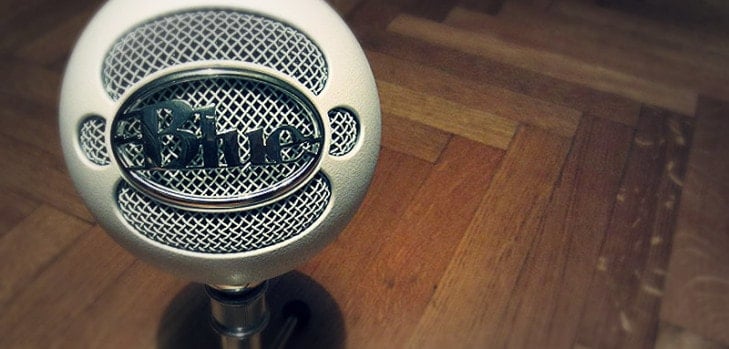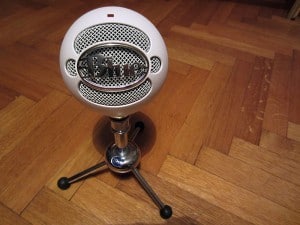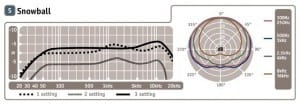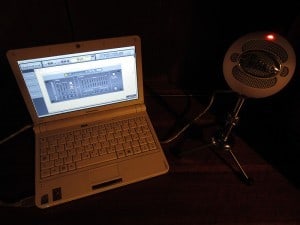Advertised as a USB microphone suitable for recording audio, creating podcasts and communicating online, Snowball by Blue Microphones caught my attention as a potentially effective affordable solution for a starter home recording setup. Since this is BPB, I guess you’ll understand why I won’t be testing how the microphone performs in the latest version of Skype – instead, this review will completely focus on how Snowball performs in a home studio setup and what benefits it can introduce to one’s music production workflow.
Before we start the test, there are a couple of facts I’d like to highlight right at the beginning, since they’re very important for evaluating the actual value of this product. First of all, Snowball is priced at around $60 in various online stores – needless to say that there aren’t too many alternative full-on home recording solutions currently available in this price range. Even if buying the cheapest possible components, a microphone/preamp/audio interface combo can hardly be purchased for anything under $100. Also, being an all-in-one USB microphone design, Snowball has one big bonus advantage over such a classic recording setup – it is a far more portable solution. So, keeping these two obvious advantages in mind, my goal was to determine whether Snowball can really provide some serious bang for a few bucks, or if it’s actually wiser to keep the money and save up for a more expensive alternative.
First Impressions
Snowball is delivered in a plastic package containing a user manual, a rugged six foot USB cable, a compact metal tripod stand, and of course the microphone itself. If you liked how Snowball looks on pictures, you’ll probably like it even more once you’ve seen it for real. Apart from the creme white version tested in this review, the microphone is available in a range of other colors which you can preview here.
The sleek vintage-y design reminiscent of old radio station microphone models works very well and the sturdy plastic-metal combo of the casing leaves an impression of decent build quality. There are no loose plastic parts or rough edges, and the microphone feels like it could take more than a few falls before taking any significant damage. Still, to prevent any unwanted interactions between the microphone and your floor, the included tripod can be used for safely setting up the microphone on a table – although it’s worth noting that Snowball is also compatible for use with standard size microphone stands.
Setting Up
After a quick inspection of the manual, it soon becomes pretty clear that Snowball was designed with ultimate Plug and Play use in mind. The hardware installation process consists of a single step – connecting the microphone to your computer using the provided USB cable. It really couldn’t be any simpler than that! No driver installation is required, and as soon as you’ve finished the hardware installation process, your OS (Windows XP SP3 in my case) will automatically recognize Snowball as an audio device. From that point on, all that’s left to do is to select Snowball as the active audio source in your recording software of choice and you’re pretty much all set, unless you’re curious about that little 3-way switch on the back of the microphone and what it actually does to the audio signal.
Are you kidding me? We’re music producers, of course we’re curious about tweaking our hardware equipment! Duh!
Ok, sorry – what the hell was I thinking? So, the three way switch located on the back side of the microphone can be used to engage one of Snowball’s three available polar patterns. The first setting puts Snowball into standard cardioid mode, which is the default mode and a setting suitable for most common uses. The second setting (with the switch in center position) activates the -10dB pad which basically provides 10dB of extra headroom while the microphone is still in cardioid mode.
This setting is suitable for louder sound sources and percussive sounds which require a higher dynamic range on the recording end. Finally, the third setting engages the omni-directional mode, which basically means that the microphone records on the front as well as the back. This is not something you’d regularly use in a studio environment, but it can come in handy for environmental recording, field recording, etc.
Time For Testing
Ok, so the mic is easy to use, it looks lovely, the setup was a breeze… I guess all that’s left now is to see how it actually performs in recording situations. Well, surprising or not, Snowball doesn’t disappoint in the sound quality department either. I’ve tested it on vocals, various percussive sounds and on an acoustic drum set in my band’s rehearsal room. In all three tests, Snowball provided acceptable results for its price range. The sound is clean, fairly transparent (although the omni mode does result in somewhat exaggerated highs) and there’s plenty of headroom on disposal, especially with the 10db pad mode engaged. We’re not talking high-end studio quality here of course, but for a starter recording setup, Snowball is more than capable of delivering the goods.
Which brings us to another important point – portability. I’ve always been a fan of field recording, capturing various sounds outside the studio and using them in various music tracks later on. Paired up with a laptop or a netbook, Snowball becomes a suitable tool for such tasks, small enough to fit in a backpack and offering results comparable to those of various dedicated field recording microphones, but available at a fraction of the price.
Speaking of portability, the mic can also be used as an instrument in live performance situations – for example, feeding audio to a vocoder plugin running live on your laptop. Snowball is also iPad compatible, making it a very good addition to a range of music making applications currently available for the iOS.
There are a few disadvantages with Snowball, though. A major issue I’ve noticed is the lack of a headphones/monitor output, which can seriously complicate things when, say, recording vocals over a backing track. Not a problem in all hosts, but there are plenty of host programs out there that don’t support separate audio interfaces for recording and monitoring. I’ve remedied the issue by using ASIO4ALL drivers, as those allow registering multiple audio devices as a single audio interface, but having a separate headphone output for monitoring would have been a great bonus. Apart from that, being able to record in 24-bit would have added a lot to the value of this mic – but I’m sure it would also negatively influence the price, so being limited to 16-bit is an understandable limitation.
Final Thoughts
So, if you ask me, a monitoring output and 24-bit recording would have made this little USB microphone an absolute and utter steal. But, considering its low price, high portability, ultimate ease of use, and more than decent sound quality, Snowball is still a good buy. This is a kind of product I would recommend to anyone looking for a quick and easy way to add audio recording capabilities to their home studio setup without breaking the $100 barrier.
It is an affordable solution for recording vocals, guitars, capturing live percussion tracks for layering over sequenced drums, etc. On top of that, the mic can also be used as a capable cheap mobile recording rig – pack it up with a little laptop and you’ll be able to record audio samples in places where you normally couldn’t bring your standard recording setup.
Finally, if you fancy the USB microphone concept of Snowball, but aren’t entirely happy with its feature set, you might want to check out the recently announced Yeti Pro – which features direct monitoring and 24-bit recording, among various other improvements.
More info: Blue Microphones Snowball ($59.99)
Snowball USB Microphone Review
Blue Microphones Snowball is an affordable USB microphone solution for basic studio usage. It can also be used as a capable cheap mobile recording rig – pack it up with a little laptop and you'll be able to record audio samples in places where you normally couldn't bring your standard recording setup.
-
Recording Quality
-
Durability
-
Portability
-
Pricing






2 Comments
gLOW-x
onNice review ;)
Samson Go Mic Compact USB is a good candidate too for portability.
And if you already got a stand, Samson CO1U USB
gLOW-x
Looks good! Thanks for the review. :)